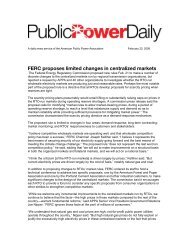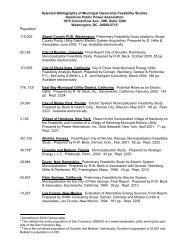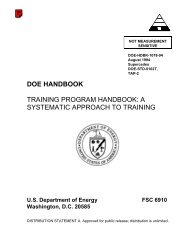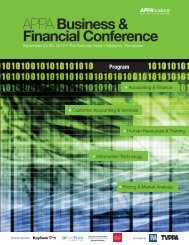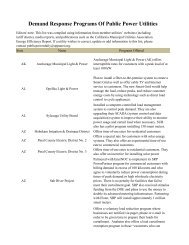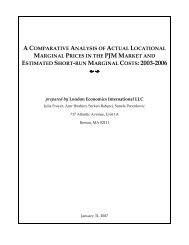2011 APPA Neophyte's Guide to Electricity - American Public Power ...
2011 APPA Neophyte's Guide to Electricity - American Public Power ...
2011 APPA Neophyte's Guide to Electricity - American Public Power ...
Create successful ePaper yourself
Turn your PDF publications into a flip-book with our unique Google optimized e-Paper software.
PJM and ISO NE operate centralized manda<strong>to</strong>ry capacity markets that<br />
procure capacity three years in advance of when it is needed. MISO, CA ISO<br />
and NY ISO have voluntary capacity markets intended <strong>to</strong> supplement capacity<br />
procured through contracts. MISO is developing a proposal <strong>to</strong> FERC for a<br />
manda<strong>to</strong>ry centralized capacity market. The CA ISO <strong>to</strong> date has decided not<br />
<strong>to</strong> implement a centralized capacity market.<br />
Demand Response<br />
Another area of increased emphasis in the last few years has been the integration<br />
of demand response in<strong>to</strong> the RTO markets. Demand response occurs<br />
when fac<strong>to</strong>ries, businesses, or groups of home owners agree <strong>to</strong> cut back on<br />
their electricity consumption during peak periods or when there is a shortage<br />
of supply resulting from high demand or unit outages. The use of demand<br />
response can reduce the cost of producing electricity because more expensive<br />
peaking plants do not have <strong>to</strong> be run, and the construction of additional<br />
plants can be avoided. RTOs generally pay for demand response either<br />
through energy markets where cus<strong>to</strong>mers voluntarily reduce their consumption<br />
during times of high prices, or through capacity markets where cus<strong>to</strong>mers<br />
must agree in advance <strong>to</strong> cut use when called upon. Demand<br />
response selling in the capacity market is often referred <strong>to</strong> as “emergency<br />
demand response” because the demand response could be utilized during<br />
periods when there is a shortage of supply.<br />
Aggrega<strong>to</strong>rs of retail cus<strong>to</strong>mers (ARC) are third-party agents that aggregate<br />
the demand response of individual retail cus<strong>to</strong>mers. ARCs then sell the<br />
aggregated demand response <strong>to</strong> utilities, RTOs and ISOs. (ARCs that resell<br />
demand response are also known as curtailment service providers or “CSPs”.)<br />
<strong>Public</strong><strong>Power</strong>.org 27



